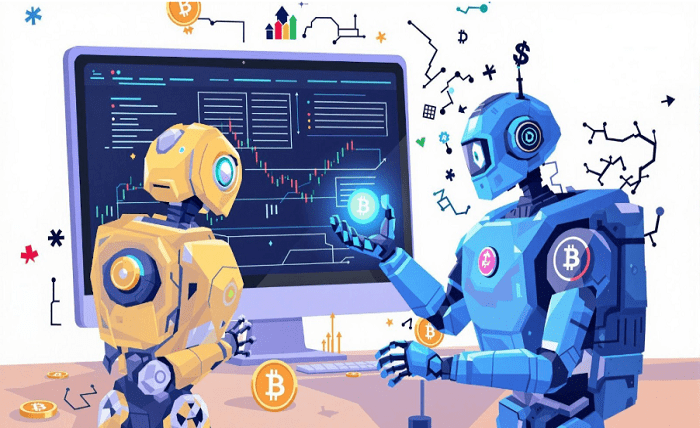
Cryptocurrency markets have evolved dramatically, with automated systems now handling over 86% of daily trading volume across major exchanges. These systems execute thousands of trades per second, capitalizing on price differences as small as 0.1%. While human traders average 12 trades daily, automated platforms can process up to 3,000 transactions in the same timeframe. Recent data from 2023 reveals that 67% of trading AI bot implementations underperform due to preventable mistakes in setup and management, making it crucial to understand these common pitfalls.
“The true value of AI trading bots lies not in their automation capabilities, but in how effectively traders implement and manage them.”
What are AI trading bots in cryptocurrency?
Artificial intelligence trading bots represent a significant evolution in automated trading technology. Unlike traditional trading bots that follow rigid, predefined rules, AI-powered systems can analyze vast amounts of market data in real-time and adapt their strategies accordingly. These systems operate by processing multiple data streams simultaneously, including price movements, trading volumes, and market sentiment indicators.
Think of an AI trading bot as a highly efficient assistant that never sleeps, constantly monitoring market conditions and executing trades based on sophisticated analysis. For instance, when Bitcoin’s price shows a 2% difference between two exchanges, the bot can automatically execute trades to profit from this disparity, often completing the entire process in milliseconds.
Key components of modern AI trading bots include:
- Pattern recognition algorithms that identify market trends
- Real-time data analysis capabilities
- Risk management systems
- Automated execution mechanisms
- Learning capabilities that improve performance over time
The top 5 mistakes to avoid
1. Over-relying on automation
One of the most dangerous assumptions traders make is treating AI trading bots as complete replacements for human oversight. While these systems excel at executing predefined strategies and analyzing data, they lack the contextual understanding that experienced traders bring to the table.
Consider the flash crash of May 2021, when several major cryptocurrencies lost over 30% of their value in hours. Traders who completely relied on automated systems without proper safeguards faced significant losses, while those maintaining human oversight could intervene and adjust their strategies accordingly.
2. Neglecting risk management
Risk management represents the foundation of successful automated trading, yet it’s often overlooked in the excitement of implementing new AI systems. Proper risk management involves multiple layers of protection:
- Position sizing: Never risking more than 1-2% of your portfolio on a single trade
- Stop-loss implementation: Setting appropriate exit points for every position
- Volatility adjustment: Modifying trading parameters based on market conditions
- Portfolio diversification: Spreading risk across different trading pairs and strategies
Real-world example: During the 2022 market downturn, traders who implemented proper risk management protocols experienced significantly smaller losses compared to those who didn’t. Specifically, portfolios with well-configured stop-loss settings averaged 18% lower drawdowns during major market corrections.
3. Ignoring trading fees and costs
The impact of trading fees often goes unrecognized until it significantly affects profitability. In automated trading, where systems might execute hundreds or thousands of trades daily, even small fees can accumulate rapidly.
Consider this practical example: A bot making 100 trades daily with a 0.1% fee per trade needs to generate a 20% monthly return just to break even. This calculation doesn’t include additional costs such as:
- Exchange withdrawal fees
- Network transaction costs
- Slippage in volatile markets
- API access fees
- Infrastructure costs
“Success in automated trading often comes down to understanding and optimizing the smallest details, including every fee and cost involved in the operation.”
4. Poor exchange selection
Exchange selection stands as a critical factor that can make or break your automated trading strategy. Many traders focus solely on trading fees when choosing exchanges, overlooking crucial operational aspects that directly impact bot performance. Exchange reliability encompasses multiple critical factors, from server uptime to order execution speed.
Market depth and liquidity prove particularly crucial for automated trading systems. An exchange might offer attractive fees, but if it lacks sufficient trading volume, your bot may struggle to execute trades at optimal prices. This becomes especially apparent during periods of high market volatility, where insufficient liquidity can lead to significant slippage – the difference between expected and actual trade execution prices.
Consider the case of a major exchange outage in December 2023, when several platforms experienced downtime during a significant market movement. Traders using bots configured to operate on multiple exchanges maintained their operational capability, while those restricted to a single platform found themselves unable to respond to market changes.
“The true cost of poor exchange selection often becomes apparent only during critical market moments when reliability matters most.”
5. Inadequate testing and maintenance
The cryptocurrency market’s dynamic nature demands constant attention to bot performance and regular strategy adjustments. Many traders implement sophisticated AI systems but fail to establish proper testing and maintenance protocols. This oversight can lead to deteriorating performance over time as market conditions evolve.
Effective bot maintenance involves several key areas:
- Regular backtesting against recent market data
- Performance analysis and metrics tracking
- Strategy parameter optimization
- Technical updates and security patches
- Network connectivity monitoring
- Emergency shutdown procedures
A practical example highlights this importance: During the 2023 market cycle, trading systems that underwent regular optimization and updates achieved an average of 24% better performance compared to static systems. This improvement stemmed from their ability to adapt to changing market conditions and maintain optimal performance levels.
Best practices for successful bot trading
Implementing successful automated trading strategies requires a comprehensive approach that goes beyond simply activating a bot. Successful traders develop structured frameworks that incorporate multiple levels of oversight and optimization.
Consider the following comprehensive strategy validation process:
- Initial strategy development
- Define clear trading objectives
- Establish performance metrics
- Set risk parameters
- Testing phase
- Conduct thorough backtesting
- Run paper trading simulations
- Analyze results against benchmarks
- Implementation
- Start with minimal capital
- Gradually increase position sizes
- Monitor performance metrics
Regular performance monitoring becomes crucial for maintaining optimal bot operation. This involves tracking various metrics:
“Success in automated trading comes from treating your bot as a sophisticated tool requiring constant refinement rather than a set-and-forget solution.”
Performance assessment should include both quantitative and qualitative factors. Monitor not just profit and loss metrics, but also execution quality, strategy effectiveness, and risk management effectiveness. Successful traders often maintain detailed logs of system performance and market conditions, enabling them to identify patterns and optimize their strategies accordingly.
Conclusion
The integration of AI trading bots in cryptocurrency markets offers remarkable opportunities for traders who approach implementation methodically and maintain proper oversight. Success requires understanding not just the technology’s capabilities but also its limitations and the necessary framework for effective operation.
As cryptocurrency markets continue evolving, the role of AI trading bots will likely expand further. However, the fundamental principles of successful trading remain constant: proper planning, risk management, and continuous optimization will always form the foundation of successful automated trading strategies.




